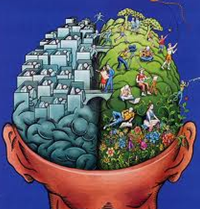
I lead creativity training for businesses and other organisations. Given the ever changing nature of the world creativity has moved from the domain of specific departments such as advertising, to become everyone’s concern and a basic leadership skill. In a fast moving world we all need to be problem solvers, innovators and change managers. Businesses that have selected people on the basis of their skill in passing academic exams or promote people on their ability to toe the party line may find this new creative reality a challenge.
Why might innovation and creativity be important in your future?
Is creativity natural? Can it be learnt in Business?
Sometimes I’m asked, “but isn’t creativity natural? Surely you have it or you don’t”. My experience is that while some seem to have an innate disposition it is mostly a matter of practice and people in businesses not only can learn but enjoy doing so. So what’s good for building business creativity?
Some things that are good for creativity:
- Curiosity, questions and tolerance for ambiguity
- Confidence (risk looking like a fool – fear kills creativity)
- Incubation/ priming (take a break)
- Accessing the unconscious (e.g. though dreams or the body)
- Joining (e.g. Yoda and stress article) and perspective diversity (seeing different angles)
- Lateral (breakthrough) and divergent thinking (not just improvement)
- Play, fantasy and relaxation
- Necessity (the mother of invention) / problem solving
- Intrinsic motivation
- Nature (even a desk-plant can help!)
- “Yes and…” thinking
- Rules and structures paradoxically can also help
One way of thinking about creativity is in terms of brain “sides”. While not strictly neurobiologically accurate it has some basis in science and is a useful analogy in any event.
“LEFT BRAIN” FUNCTIONS:
uses logic, detail oriented, facts rule, words and language, present and past, maths and science, can comprehend, knowing, acknowledges, order/pattern perception, knows object name, reality based, forms strategies, practical, safe
“RIGHT BRAIN” FUNCTIONS:
uses feeling, “big picture” oriented, imagination rules, symbols and images, present and future, philosophy & religion, can “get it” (i.e. meaning), believes, appreciates, spatial perception, knows object function, fantasy based, presents possibilities, impetuous, risk taking
Some Creativity Tools
– Thinking hats
These can be applied by one person in sequence or assigned to different people in a team meeting to get different perspectives on an issue:
- Random idea generation – e.g. using “found objects” or on a walk
- Reversals (e.g. “How to send HR managers crazy”), exaggerations (The best team in the world!), challenging assumptions (e.g. “why do radios need batteries?”).
- Play! Play is the fundamental way we learn and create yet is underused at work (not the opposite of play any more)
Managerial principles that encourage creativity
So how can business mangers encourage creativity? Here are a few simple things:
- Challenge – matching people with the right assignments
- Freedom – giving people autonomy, choosing means to achieve goals
- Resources – such as time, money, space etc. A balanced fit among resources and people
- Work group features – diverse, supportive teams, where members share the excitement, willingness to help and recognise each other’s talents. Team members change regularly
- Supervisory encouragement – recognition, praise, gratitude
- Organisational support – value emphasis, information sharing, collaboration
If you have enjoyed this article you may like to take a look at:
If your organisation is looking at creativity training in the workplace then call us on 01273 906828 .
To receive the Integration Training newsletter with free tips and news of events please click on the link below
Sign up for our Email Newsletter

rick clairs
I like this, and i follow so that i can develop the creative ways to make Business Creativity , that has to do with the mind. Surely i hope that this will work for me and others business consultants.